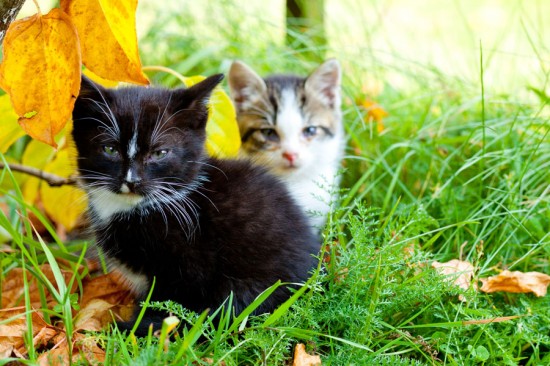

It will happen when you least expect it: you’ll be walking home from work or hiking through the woods. It could be the middle of the night. You may see something moving out of the corner of your eye, or hear faint meowing from a bush. When you see a stray kitten, it may be so young that you don’t even recognise it as a cat. You’ll know by instinct that you’ll need to act fast, but what steps should you take? How can you find the mother, or an owner if there is one? Read this article to learn what you should do if you spot a stray kitten, and how to help young cats that appear lost or abandoned.
Before you rush to handle a young stray kitten, remember that the mother could be nearby, watching and waiting for you to leave. This is especially true in cases where the mother and kittens are strays or feral. Try to distance yourself from the kitten, but remain close enough that you can see whether the mother comes back.
If you do see the mother return, take note of your location and contact a local charity. Let them know that you’ve spotted a stray cat. Some charities run schemes whereby they will catch, spay and release feral cats to try and control the stray cat population. See if any of these operate in your area, or call Cats Protection for more information.
If the mother cat does not return, follow the next few steps.
No matter what the age of the kitten, make sure it is able to breathe clearly. Check its paws and body: are they cold to the touch? Do you notice any discharge from its eyes or nose? These are signs that the kitten needs veterinary attention right away. If you can get to a local charity that has a veterinary clinic onsite it may be best to try contacting them first. Explain the situation and ask for advice. A private veterinary surgery may also be able to point you in the right direction, but always call before bringing the kitten in to discuss the best course of action.
Older kittens that have grown up outdoors may not be used to human contact. Take special care when approaching a cat that is displaying signs of nervousness: crouching, growling and hissing cats may bite or scratch if frightened. Call an animal rescue group if you cannot handle it yourself. If the kitten is overtly friendly, it may be someone’s pet and you should report it as found with the authorities. In either case, it’s important that you handle and transport the kitten securely, such as in a carrier or well-ventilated box.
This is best done by a vet, but if it’s the middle of the night or you cannot reach one straight away, use the following criteria to estimate its age:
The older the kitten is, the better its prospects of survival.
Feeding a newborn kitten (up to two weeks) is complicated and requires serious commitment, as they will not survive without feeding and eliminating every two hours. Your local vet or emergency clinic should have commercial kitten formula on hand that is easy to mix and dose, along with a kitten feeding kit consisting of a small bottle or dropper. Remember to dispense the formula slowly and always ensure that it is free of lumps before feeding. Cat milk and dairy milk are not acceptable substitutes for kitten formula, so it is imperative that you contact a veterinary surgery to get an appropriate kitten diet right away. Help your kitten to eliminate after eating by dampening a cloth with warm water and gently rubbing between its back legs.
Older kittens (two weeks to four weeks) can be fed kitten formula every 4-5 hours, and kittens on the brink of being weaned (five to eight weeks) can be offered well ground kitten food and formula to lap at as they wish. Always follow the feeding guide on the tin to avoid under of overfeeding.
Both young and more mature kittens should be kept warm and dry at all times whilst in your care. Set up a secure space with warm, preferably absorbent blankets in an area that is free from draughts. You can also use hot water bottles or a heat mat under a blanket, but always make sure it is easy for the kitten to move off the heat source to avoid overheating. Check your kitten regularly to make sure he is warm and comfortable.
The above tips are intended for temporary, emergency scenarios: they are by no means a substitute for a veterinary examination and advice. Caring for a stray kitten is a huge commitment, especially if the kitten is at its earliest life phase. The best care way to ensure a young kitten’s survival is to leave it with its mother or find a surrogate – local rescue groups may be able to place an orphaned kitten with another litter of the same age, so get in touch. If you have found an older kitten and wish to keep it, be sure to visit a vet and have a full examination done, including a microchip check. They will then tell you the steps you need to follow in order to try and find an owner or report it found.
 11 Ways To Minimise Exposure To Environmental Allergens In Dogs
11 Ways To Minimi
11 Ways To Minimise Exposure To Environmental Allergens In Dogs
11 Ways To Minimi
 Dogs are people too!!!
Dogs are people too!!!
A definitive open delib
Dogs are people too!!!
Dogs are people too!!!
A definitive open delib
 Decoding Your Dog’s Calming Signals
Decoding Your Dog
Decoding Your Dog’s Calming Signals
Decoding Your Dog
 Acute Moist Dermatitis In Dogs
Acute Moist Derma
Acute Moist Dermatitis In Dogs
Acute Moist Derma
 Heatstroke And Dogs - Keeping Your Dog Safe From Overheating In The Summer
Heatstroke And Do
Heatstroke And Dogs - Keeping Your Dog Safe From Overheating In The Summer
Heatstroke And Do
Copyright © 2005-2016 Pet Information All Rights Reserved
Contact us: www162date@outlook.com